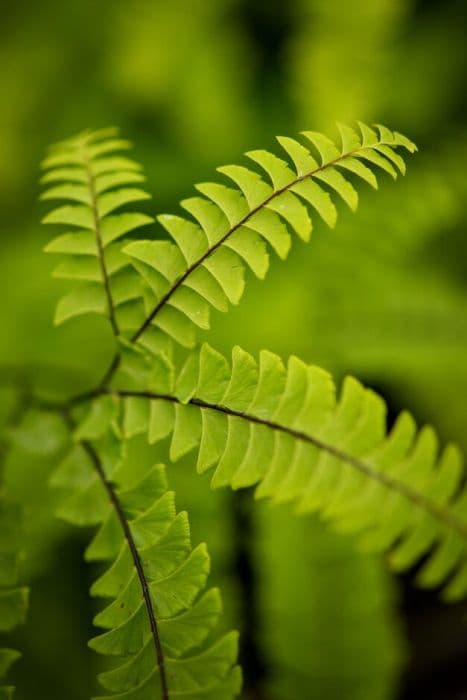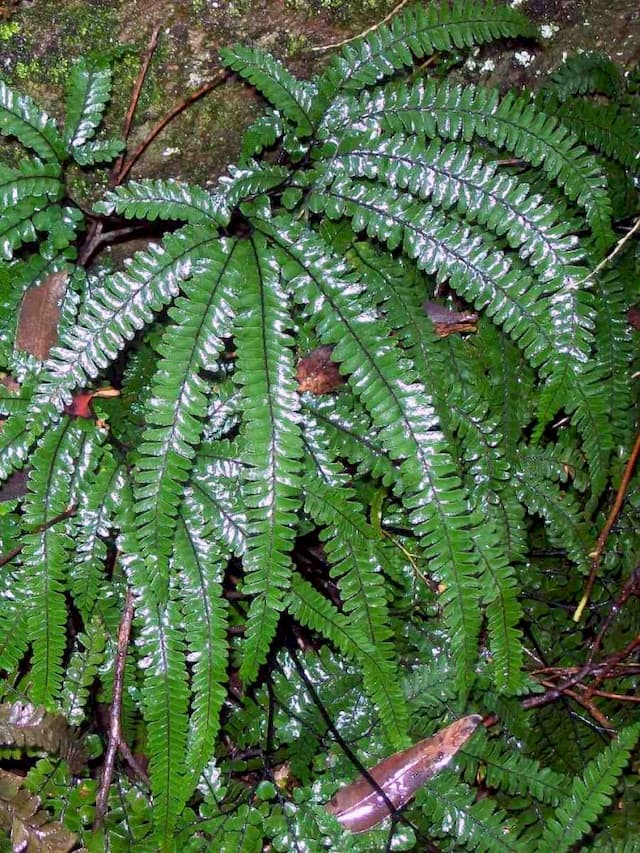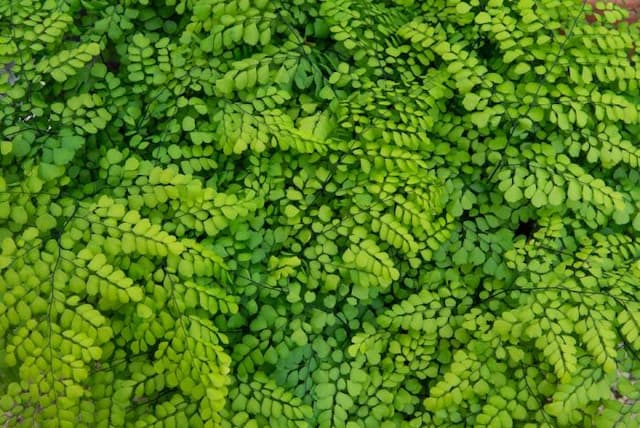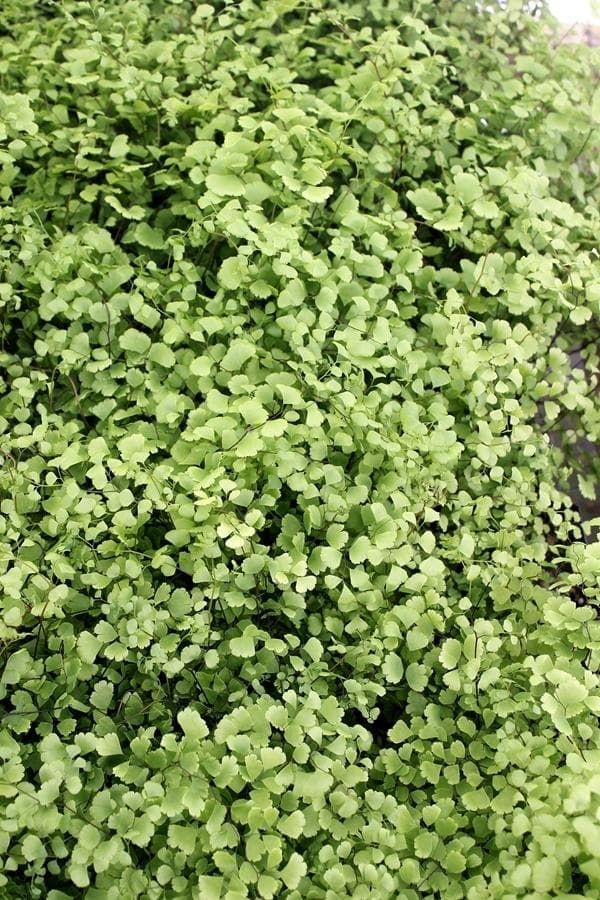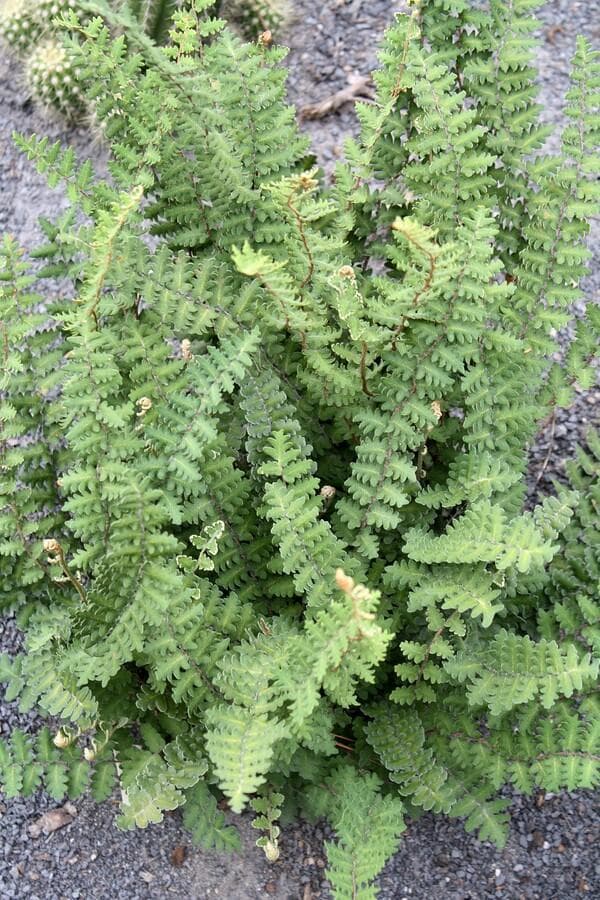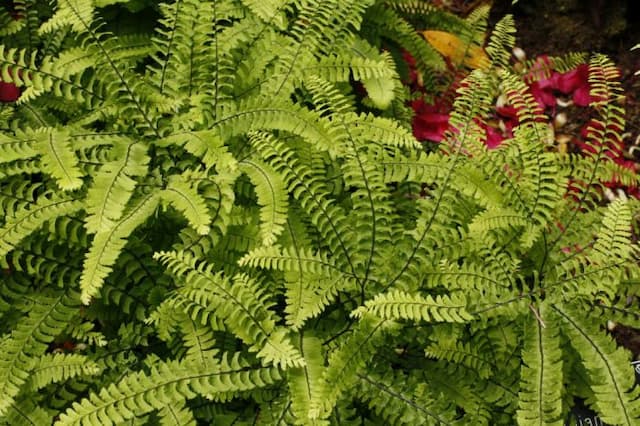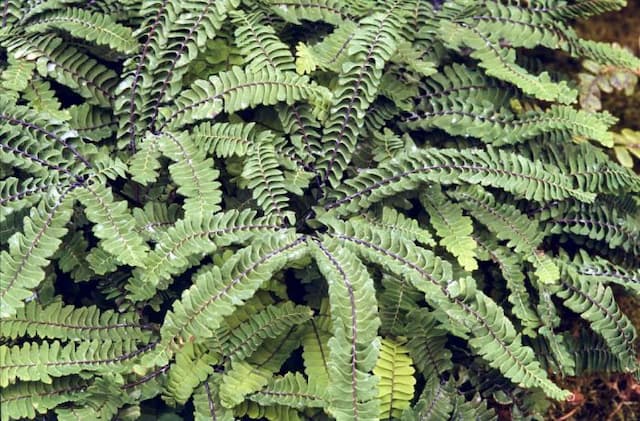Button Fern Pellaea rotundifolia

ABOUT
Pellaea rotundifolia, also known as the button fern, is a perennial plant that sports a distinctive and attractive appearance. The foliage is the highlight of this plant, characterized by small, round to oval, button-like leaves that are arranged neatly along delicate, arching stems. These leaves have a rich, dark green color that can add a touch of lushness to any setting. The button fern has a compact and tidy growth habit, contributing to its popularity as a houseplant. The stems themselves tend to be slender and may possess a wiry quality, providing a nice contrast with the soft texture of the leaves. This plant has a refined look that makes it especially appealing for those who appreciate subtlety and elegance in plant forms. Its foliage is evergreen, which means that the plant maintains its verdant appearance throughout the year. This characteristic makes the button fern an ideal choice for bringing consistent greenery into indoor spaces. Overall, the visual appeal of Pellaea rotundifolia lies in its delicate, rounded leaves and the graceful, overhanging manner in which they are presented.
About this plant
 Names
NamesFamily
Pteridaceae
Synonyms
Button Fern, Round-leaf Fern, Button Leaf Fern, Round Leaved Fern
Common names
Pellaea falcata var. rotundifolia, Allosorus rotundifolius.
 Toxicity
ToxicityTo humans
Button fern (Pellaea rotundifolia) is generally considered non-toxic to humans. Therefore, accidental ingestion of this plant is not expected to cause poisoning or produce harmful symptoms.
To pets
Button fern (Pellaea rotundifolia) is also non-toxic to pets and does not cause symptoms of poisoning when ingested. Hence, it is considered safe around common household pets such as cats and dogs.
 Characteristics
CharacteristicsLife cycle
Perennials
Foliage type
Evergreen
Color of leaves
Green
Height
1 foot (30 cm)
Spread
1 foot (30 cm)
Plant type
Fern
Hardiness zones
9
Native area
New Zealand
Benefits
 General Benefits
General Benefits- Easy Care: Pellaea rotundifolia, commonly known as button fern, is a hardy plant that is relatively easy to maintain, tolerating occasional neglect.
- Aesthetic Appeal: With its round, button-like leaves and attractive fern texture, it adds a unique visual interest to indoor spaces.
- Humidity Tolerance: Button fern can thrive in a range of humidity levels, making it suitable for various indoor environments.
- Non-Toxic: It is safe for pets and children, as it is not known to be toxic when ingested.
- Compact Size: Due to its compact growth habit, it is ideal for smaller spaces such as desks, shelves, or as part of a terrarium.
- Versatile Decoration: Its understated elegance allows it to blend seamlessly with different decor styles, from modern to traditional.
- Longevity: With proper care, button fern can be a long-lived plant, providing years of enjoyment.
 Medical Properties
Medical PropertiesThis plant is not used for medical purposes.
 Air-purifying Qualities
Air-purifying QualitiesThis plant is not specifically known for air purifying qualities.
 Other Uses
Other Uses- Button ferns can be used in terrariums or fairy gardens due to their small size and ability to thrive in the humid, controlled environments these mini-ecosystems provide.
- Pellaea rotundifolia may be utilized in green walls or vertical gardens, which are particularly popular in urban environments where space is limited.
- As a non-toxic plant, it can be safely grown in households with pets, offering a pet-friendly option for plant enthusiasts.
- The textures and shades of button ferns can be used in floral arrangements and bouquets, often as a lasting, green accent.
- These ferns can be an educational tool in schools or at home due to their distinct life cycle and ease of care, making them ideal for teaching children about plant growth and biology.
- Button ferns can serve as a natural humidifier in small spaces, helping to maintain moisture levels without the use of electronic devices.
- They can be used in bottle gardens, a form of enclosed terrarium, where they thrive due to their preference for indirect light and high humidity.
- In film or theatre, Pellaea rotundifolia can be used as a set decoration to create realistic forest scenes or to add greenery to indoor sets.
- Button ferns can be given as eco-friendly gifts or favors at events like weddings, symbolizing endurance and resourcefulness.
- In photography, the delicate structure and greenery of button ferns make them an interesting subject or backdrop for macro photography.
Interesting Facts
 Feng Shui
Feng ShuiButton fern is not used in Feng Shui practice.
 Zodiac Sign Compitability
Zodiac Sign CompitabilityButton fern is not used in astrology practice.
 Plant Symbolism
Plant Symbolism- Resilience: Button fern, as Pellaea rotundifolia is commonly known, demonstrates strong resilience by thriving in a variety of conditions including rocky environments and low nutrient soil, symbolizing the ability to persist and adapt in challenging circumstances.
- Endurance: The plant's hardy nature reflects qualities of endurance and the ability to withstand climate variations, suggesting a symbolic meaning of perseverance.
- Elegance: Button fern's delicate, rounded leaves offer an elegant appearance, making it symbolic of grace and refined beauty.
- Renewal: As a fern, the button fern is part of a group of ancient plants that have existed for millions of years, thus representing renewal and the ongoing cycle of life and rejuvenation.
 Water
WaterButton fern should be watered thoroughly, allowing the top inch of the soil to dry out before watering again. This usually means watering the plant approximately once a week, but the frequency can vary depending on the humidity and temperature of the environment. When watering, aim to use about 8 to 16 ounces of water, depending on the size of the pot—a smaller container may require less, a larger one might need more. Be careful to avoid waterlogging the soil as button ferns do not like to sit in water, which can lead to root rot.
 Light
LightButton fern thrives best in bright, indirect light. It should be placed in a spot where it will receive plenty of light but is shielded from direct sunlight, which can scorch its delicate leaves. An east-facing window with sheer curtains or a north-facing window would be an ideal location for a button fern to ensure it receives the right amount of light without being exposed to harsh sun rays.
 Temperature
TemperatureButton fern prefers a temperature range between 60 to 75 degrees Fahrenheit. The plant can tolerate a minimum temperature of around 50 degrees Fahrenheit, but it should be protected from temperatures below that as it can cause damage to the plant. Keeping it in a room that maintains a consistent temperature within the ideal range will promote healthy growth.
 Pruning
PruningButton fern typically requires minimal pruning. Trimming may be done to remove any brown or dead fronds to keep the plant looking tidy and to encourage new growth. The best time to prune is in spring when the plant begins its growth cycle. You can prune every few months or as needed when you notice dead or damaged fronds.
 Cleaning
CleaningAs needed
 Soil
SoilButton fern thrives in a soil mix that is well-draining and rich in organic matter, such as a blend of peat, perlite, and pine bark. Aim for a soil pH between 6.0 to 7.0 for optimal growth.
 Repotting
RepottingButton ferns generally need to be repotted every two to three years to refresh the soil and accommodate root growth. Do so more frequently if the plant outgrows its pot.
 Humidity & Misting
Humidity & MistingButton fern prefers higher humidity levels, ideally between 40% to 50%; misting the plant can help maintain these conditions.
 Suitable locations
Suitable locationsIndoor
Place Button fern in bright, indirect light and keep soil moist.
Outdoor
Grow Button fern in shady areas with moist, well-draining soil.
Hardiness zone
10-12 USDA
 Life cycle
Life cycleButton fern (Pellaea rotundifolia) begins its life cycle as a spore, which germinates under suitable moist and warm conditions to form a prothallus, a small, heart-shaped gametophyte. This gametophyte houses both male and female reproductive organs, the antheridia and archegonia, which when mature can produce sperm and eggs respectively. Fertilization occurs when water allows sperm to swim to the eggs, resulting in a zygote that grows into a sporophyte—the familiar fern plant. The sporophyte matures and develops fronds that uncurl from fiddleheads, and on the undersides of these fronds, specialized clusters of cells called sori form. These sori produce spores that are eventually released into the air to disperse and start the cycle anew. Throughout its life, the button fern thrives in moist, shady environments, requiring minimal care to grow successfully in suitable indoor and outdoor settings.
 Propogation
PropogationPropogation time
Spring-Early Summer
The most popular method of propagation for the Button Fern (Pellaea rotundifolia) is by division, ideally performed during the spring growth season. To propagate by division, gently remove the fern from its pot and determine natural divisions or clusters of fronds with their own root systems. Using clean, sharp scissors or a knife, carefully separate these clusters, making sure each new section has a fair amount of roots attached. After dividing, pot each new fern into a container with well-draining soil, ideally a mix suitable for ferns, and water them lightly to settle the soil around the roots. After potting, place the divisions in indirect light and keep the soil consistently moist but not waterlogged to encourage growth.
